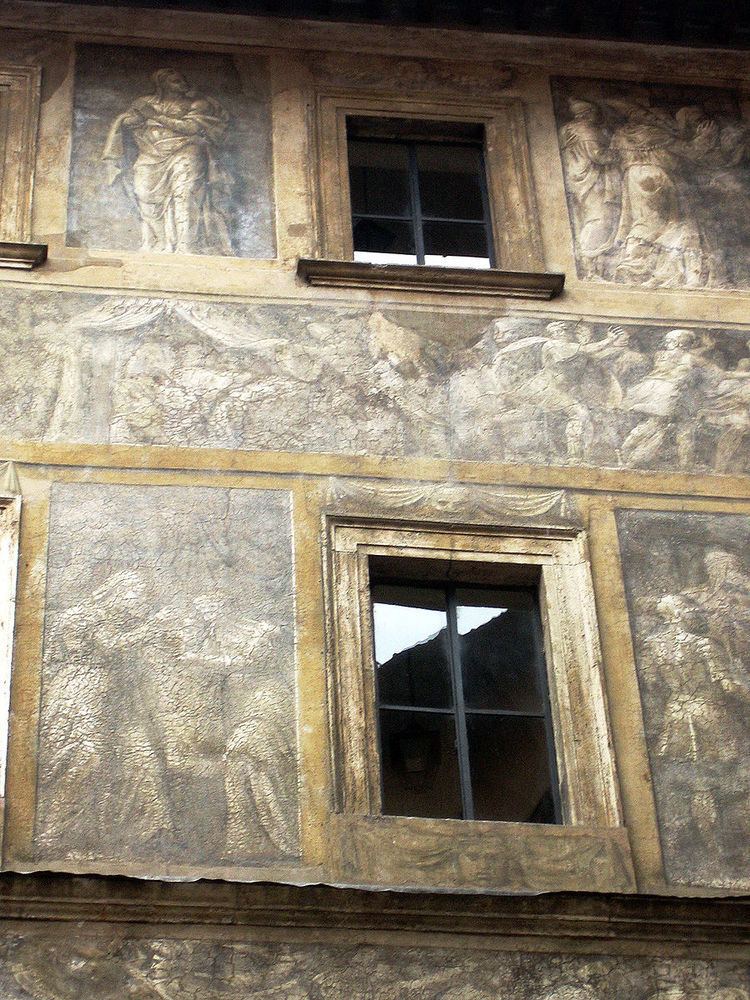 | ||
Sgraffito ([zɡrafˈfiːto]; plural: sgraffiti; sometimes spelled scraffito) is a technique either of wall decor, produced by applying layers of plaster tinted in contrasting colours to a moistened surface, or in pottery, by applying to an unfired ceramic body two successive layers of contrasting slip or glaze, and then in either case scratching so as to reveal parts of the underlying layer. The Italian past participle "sgraffiato" is also used, especially of pottery.
Contents
Etymology
Sgraffito and sgraffiti come from the Italian word graffiare ("to scratch"), ultimately from the Greek γράφειν (gráphein, "to write"). Related terms include graffito and graffiti.
History
Sgraffito on walls has been used in Europe since classical times, it was popularized in Italy in the 15th and 16th centuries and can be found in African art. In combination with ornamental decoration these techniques formed an alternative to the prevailing painting of walls. Of late there has been an unmistakable growing interest in this old technique. The technical procedure is relatively simple, and the procedures are similar to the painting of frescoes.
Sgraffito played a significant role during the years of the Renaissance in Italy, with two of Raphael's workshop, Polidoro da Caravaggio and his partner Maturino da Firenze, among the leading specialists, painting palace facades in Rome and other cities. Most of their work has now weathered away. During the 16th century, the technique was brought to Germany by the master builders of the Renaissance and taken up with enthusiasm. As a simple native art, old examples of sgraffito can be found in the wide surroundings of Wetterau and Marburg. In Germany, the technique is most predominant in Bavaria. The use of sgraffito was common in the creation of housing façades for the purposes of advertising. The technique was also used in Thuringia, the Engadin, Austria and Transylvania.
In Catalonia, sgraffito was implemented in the early 20th century by the Noucentista neo-classical architects and became a recurrent technique in façade decoration.
Another use of sgraffito is seen in its simplified painting technique. One coat of paint is left to dry on a canvas or sheet of paper. Another coat of a different color is painted on top of the first layer. The artist then uses a palette knife or oil stick to scratch out a design, leaving behind an image in the color of the first coat of paint. This can also be achieved by using oil pastels for the first layer and black ink for the top layer. Sometimes a first coat of paint is not needed, and the wet coat scraped back reveals the canvas. This cannot be achieved by using the oil pastel method. This technique is often used in art classes to teach the sgraffito technique to novice art students.
Art Nouveau
Examples of graphic work on facades saw a resurgence circa 1890 through 1915, in the context of the rise of the Arts and Crafts Movement, the Vienna Secession, and particularly the Art Nouveau movement in Belgium and France.
The English artist Heywood Sumner has been identified as this era's pioneer of the technique, for example his work at the 1892 St Mary's Church, Sunbury, Surrey. Sumner's work is sgraffito per se, scratched plaster, but the term has come to encompass a variety of techniques for producing exterior graphic decoration.
Other examples include:
